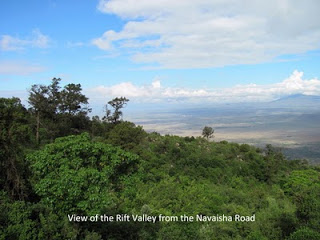Any of the geography books you read about Kenya talk about how the country
is divided by the Great Rift Valley, and it is interesting to contemplate
how it all came about, how all that geographical and geological crushing
created such a huge space (they say it is about 5,000 miles from top to
bottom, going from Lebanon down to the lower reaches of Mozambique). Seeing
the valley was an added bonus for me, since I was on my way to enjoy my
safari in Lake Nakuru National Park, and my wonderful driver had the good
idea of travelling up one road and back another, so I would be guaranteed to
have a good view of this beautiful place.
So off we went, travelling first up the Naivasha Road, running between
Nairobi and Naivasha and joining up just beyond Naivasha with the other road
(designed specifically for viewing, with minimal truck traffic) to go on up
– paralleling the valley all the way – to Nakuru and beyond. Nakuru is
Kenya’s fourth largest city (there are only four), so there is lots of truck
traffic heading back and forth between Nairobi and Nakuru, so it’s easy to
see why they needed a second road. I’m glad they kept the trucks off it
(well, for the most part).
It’s hard to describe the beauty of these views. The many lakes of the
valley add to the splendor, and make the trip especially satisfying. There
are no outlets for water in the valley, so it just backs up and forms into
these lovely lakes, and combined with the elegance of the several extinct
(thank goodness!) volcanoes, you can see why it is such a special visual
experience. And I love the names of the lakes: Naivasha, Elmenteita, Nakuru,
Bogoria, Baringo. Then when you start talking about the mountains as well –
Mount Elgon, Mount Longonot (not extinct, just “dormant” – oh, dear!), the
Menengei Crater – it becomes clear why the language is so lovely to hear.
Just wish I were better with languages, for I would love to be able to speak
Kiswahili or one of the many soaring Kenyan languages. It is a real treat
just to stand and listen to people talk!
This is great farming country – contributing a great proportion of Kenya’s
foodstuff – and it’s hard to think about how at the top of the valley it’s
all desert, and then down at the bottom it’s all flat arid plains. But why
not? Over 5,000 miles I suppose the landscape can change.
The roads (both of them) are pretty much up and down (and, yes, they have
their curvy and very scary parts) but there are handsome overlooks from time
to time, and it is very pleasant to stop along the way, snap some pictures
of the view, and have a casual conversation with the folks who run the curio
shops. Of course the shops are ubiquitous here, as in many other places
where visitors might pass by, but these particular curio shops seem to be
specially inviting. Very sweet people, not at all pushing one to buy, and at
the same time offering very nice merchandise at very reasonable prices. What
a nice way to begin a safari!



Leave a Reply